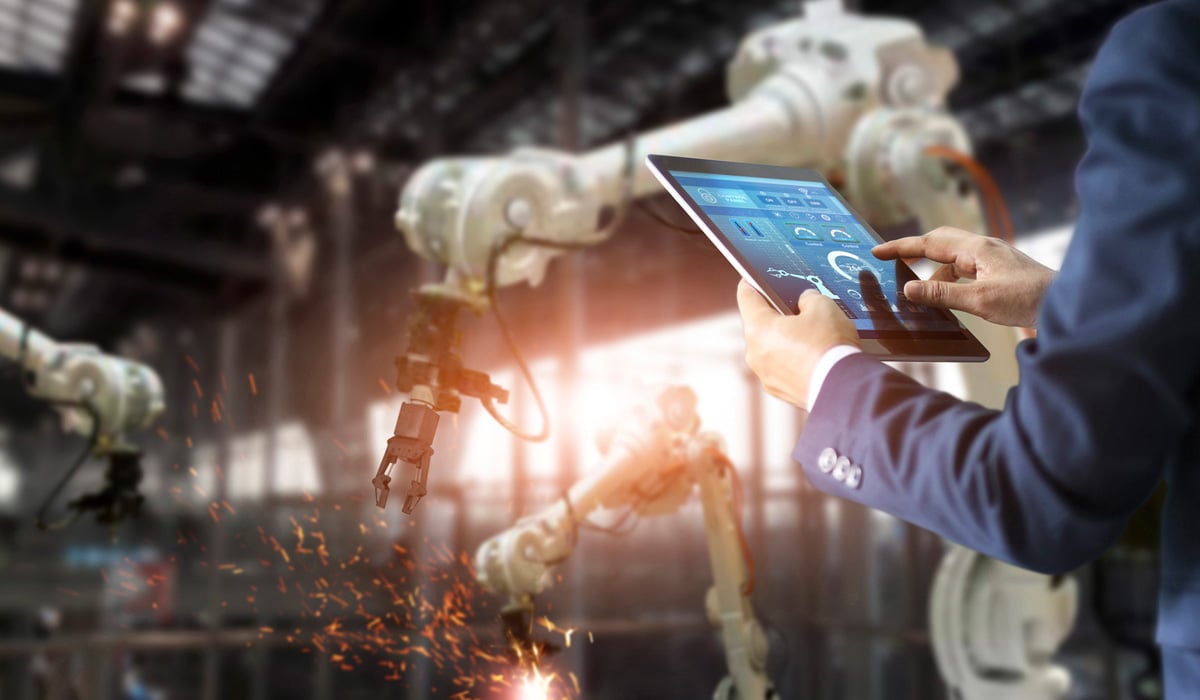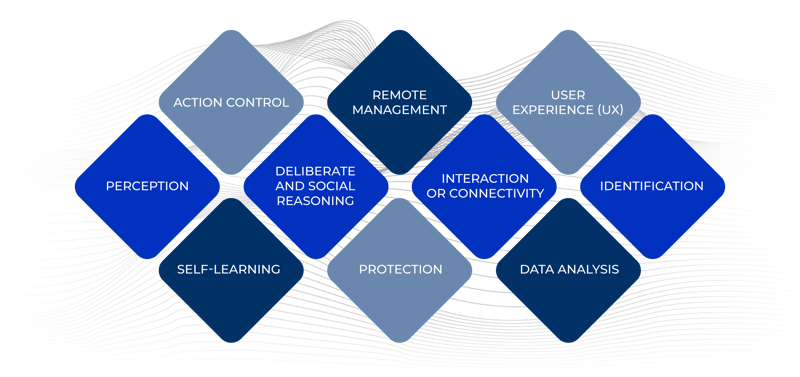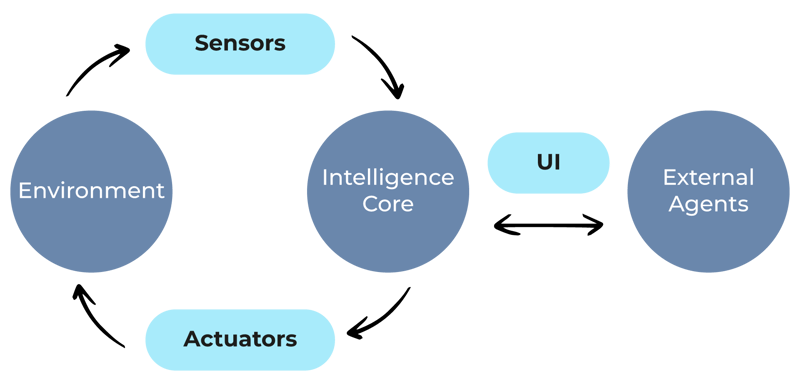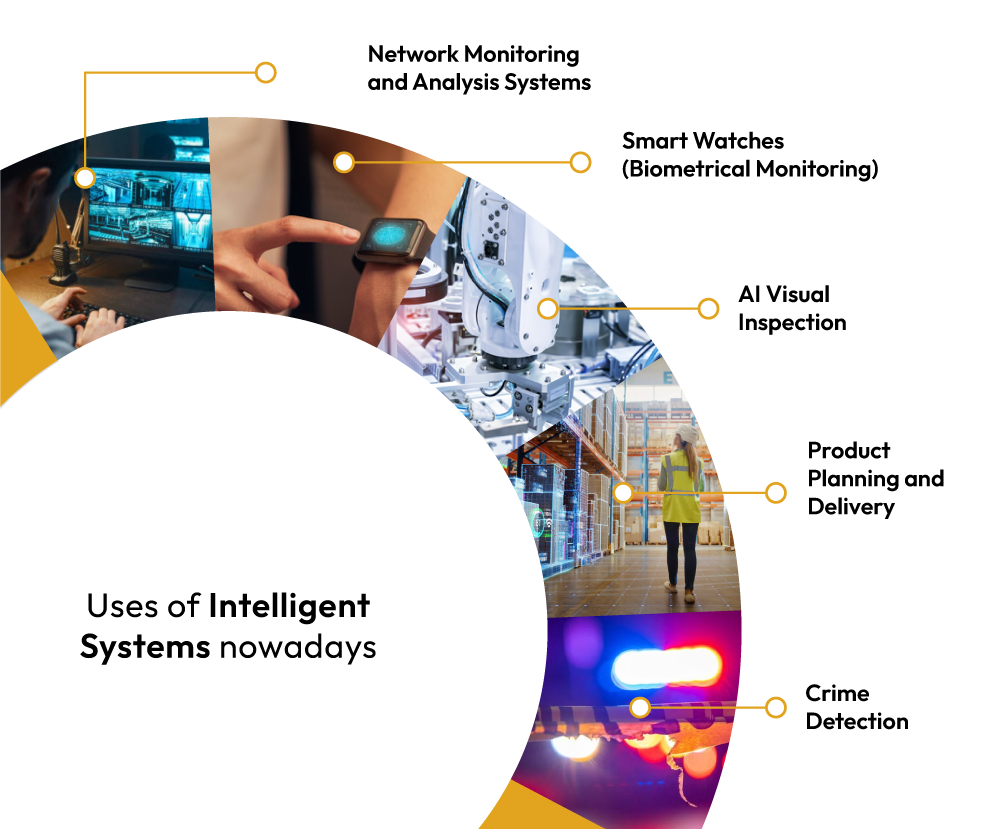
Intelligent systems solve complex problems automatically and more efficiently within specific environments. They are formed by the collaboration of people and technologies such as Big Data, the IoT ("Internet of things"), mobile networks (3G, 4G, 5G) AI or artificial intelligence, robotics, video analytics, computer vision, and augmented reality, among others.
In this article, we will discuss what intelligent systems are, their origins, operation, components, and applications most used today, in addition to mentioning how Autonomous Artificial Intelligence can elevate their operations.
Table of contents
- What are intelligent systems?
- How do intelligent systems work?
- Properties of intelligent systems
- History of Industry 4.0
- What is the Internet of Things (IoT)?
- What is cloud computing?
- Applications of intelligent systems
- 4 Companies using intelligent systems
- Examples of Intelligent Systems
- Intelligent systems and autonomous AI
What are intelligent systems?
Intelligent systems are a technology that has emerged and become more important in the last decade.
Intelligent systems are the answer to the accelerated technological growth of recent years and the needs of people and organizations in an increasingly interconnected world.
In this context, intelligent systems involve various physical, digital and human parts to achieve a common goal. The rearrangement, interaction and learning between all these components is part of the transformation of Industry 4.0.
Industry 4.0 seeks to modify current companies' working models so they can adapt and grow in this new collaborative environment between machines and humans. At Algotive, we call it the machine-colleague experience.
The interconnectivity and relationship between each of the components of intelligent systems is what makes it "intelligent".
A strict definition of an intelligent system is given by Martin Molina in his paper, "What is an intelligent system?" published by the Technical University of Madrid:
“An intelligent system operates in an environment with other agents, possesses cognitive capabilities such as perception, action control, deliberative reasoning or language, follows principles of behavior based on rationality and social norms, and has the ability to adapt by learning."
How do intelligent systems work?
Generally, intelligent systems use IP (Internet Protocol) technology and sensors to collect information from a specific environment and share it among its different elements to achieve a common goal.
This interconnection between the digital and physical worlds is called the Internet of Things. On the other hand, Big Data is another element that makes this type of system possible to collect information and knowledge within a system. And this same technology learns from its experiences with artificial intelligence technologies and its main subfield, machine learning.
Learn more about Data Science and how it works with AI in our full article here.
10 CHARACTERISTICS OF INTELLIGENT SYSTEMS

The main characteristics of an intelligent system are:
Perception: An intelligent system creates a representation of the world to interact with a specific environment and perform tasks.
Action Control: An intelligent system can carry out actions or interrupt actions to achieve a goal.
Interaction or connectivity: An intelligent system can put its elements into communication through a common language.
Deliberate and social reasoning: The machine makes decisions on its own to achieve a specific result, considering the human context.
Self-Learning: Intelligent systems can reduce errors and optimize their performance by learning from their own experiences.
Identification: Intelligent systems can recognize specific information automatically and transmit it through various channels.
Protection: An intelligent system's networks and communications must be secure to function properly.
Remote Management: An intelligent system allows people to interact with it from any location.
User Experience (UX): To interact with users, intelligent systems must have accessible and adjustable interfaces.
Data Analytics: An essential component of an intelligent system is its ability to process immense amounts of data.
Properties of intelligent systems
Intelligent systems have fundamental similarities, but depending on the industry, they can vary greatly.
Here are 6 elementary properties of intelligent systems:
1. Sensors
The technology collects data from the environment and transmits it to the intelligent core for identification and analysis.
2. Actuators
They perform the actions that the intelligence core determines once it analyzes the environment in real-time.
3. Specific environment
It is the context that the intelligent system analyzes and modifies. They can be static, discrete, episodic, deterministic, or known.
4. Intelligence Core
Artificial intelligence and machine learning are the pillars of this section. It is what makes it possible to generate situational awareness and learn from the situation. l User interface (UI).
5. User Interface (UI)
It is the way an external agent communicates and alters the relationship between the system and the environment.
6. External Agents
The people who oversee the process of the intelligent system or even other artificial intelligence.
INTELLIGENT SYSTEMS FUNCTIONALITY

History of Industry 4.0
Industry 4.0 or also known as IoT is a new phase within the industrial revolution focused on interconnectivity, automation, big data, machine learning, and real-time data being of special help to companies in manufacturing and supply chain management.
Technology has created the industrial revolution since the 19th century, where each phase has been recognized by technologies such as mechanization, electricity, computing and digitization, over time it has created an impressive change for companies and workers.
The first industrial revolution
The first industrial revolution occurred between the late 18th and early 19th centuries. This movement ushered in a period of growth and profound transformation in the systems of work and structure of society.
Manufacturing evolved to optimize manual labor performed by people and supported by animals. It mainly consisted of replacing the old handmade tools with more productive machines powered by steam or water along with other machines.
The second industrial revolution
At the beginning of the 20th century, we entered the second industrial revolution where industrial and social changes were generated and the economic model improved thanks to the introduction of steel, chemical products, the use of electricity in factories and the obtaining of new forms of energy.
The introduction of electricity allowed manufacturing companies to increase their efficiency, dynamism and productivity, giving local markets the opportunity to expand and internationalize.
The third industrial revolution
The third industrial revolution took place in the middle of the 20th century, when manufacturing companies began to incorporate more technologies until the implementation of computers in factories.
This stage is characterized by the use of renewable energies, smart electric power, conversion of buildings into power plants and more internet communication technologies and renewable energies.
During this period, manufacturing companies began to experience a shift with less analog and mechanical technologies and more on digital technology and automation software.
The fourth industrial revolution, or Industry 4.0
In recent decades, a fourth industrial revolution, known as Industry 4.0, has emerged. This new stage is committed to greater automation, connectivity and globalization.
It emphasizes the digital technology of recent decades and takes it to a whole new level with the help of interconnectivity through the Internet of Things (IoT), access to real-time data, and the introduction of cyber-physical systems.
It has allowed to connect the physical with the digital enabling better collaboration and access for all departments, partners, suppliers, products, and organizations.

What is the Internet of Things (IoT)?
The Internet of Things (IoT) is the process of connecting everyday physical items to the Internet equipped with sensors, software, and other technologies to receive data from other objects. In general, this smart technology helps things work better, more productively, and synchronized.
The IoT consists of smart devices connected and adapted for the web using integrated systems such as hardware, processors, and communication sensors that allow them to intervene in the collection and transfer of information and take actions depending on the environment they are directed to.
The IoT ecosystem only requires human intervention and a computer to set up its configuration and give it specific instructions to carry out. An important factor of this tool is that it interacts with artificial intelligence using machine learning to help it make information-gathering processes easier and more dynamic.
The goal of IoT is to analyze data and automate subsequent decisions or actions.
This is the IoT process in 4 steps:
1. Capturing data
This process is through sensors where IoT devices capture data and information from their environments such as temperature or a real-time video.
2. Sharing the data
Using available network connections the devices will give you access to the data through a private or public cloud.
3. Processing the data
This process consists of programming the software to perform actions or make decisions based on the data.
4. Acting on the data
The accumulated data from all devices in an IoT network is analyzed. This provides strategic information to inform reliable business decisions and actions.
IoT brings numerous benefits in both home and commercial environments. This tool can improve usability and efficiency within a company to save time and money, it facilitates access to information regardless of location, time, or device, it has dynamic and efficient data transfer, as well as the ability to increase security in alarms, locks, and cameras to reinforce protection in a home or work.
This technology has shown us that it has hundreds of tools that will improve the lifestyle of people and organizations having more and more present in our daily lives.
If you want to learn more about how this technology works and its impact, read our full article on the Internet of Things (IoT) here.
What is cloud computing?
Cloud computing or also known as "cloud technology" focuses on offering computer services remotely by hosting information in external data centers. It is a technology that allows the use of different services such as file storage, application use, or device connection, without taking up space on a computer's hard drive.
Cloud computing allows remote access to software, file storage, and data processing through the Internet and devices such as computers, smartphones, and portable accessories connected wirelessly.
3 most important features of cloud computing:
Offsite storage:
This is the most well-known application of cloud computing. It allows any person or company to store files in an internet space without taking up hard disk space. There are hundreds of external storage systems ranging from personal storage, to backups for email, photos, videos, and other personal files, but we also find for business storage so that data files and more can be transferred and stored.
Use of online applications:
This tool provides a great value to companies being very useful for any type of application such as design, IT, accounting, and more thanks to saving installation space on the computers of the collaborators, allowing everyone to use the same application and there is an integration of work within the organization.
Connecting from anywhere and at any time:
Cloud computing is a technology that can be accessed from any place and device with the right access you can view all the information stored in the cloud and use all the online applications installed.
In addition to these three features that give added value to the company to streamline the work of employees, there are hundreds of key benefits that companies would get by adopting the cloud infrastructure.
A clear example of the benefits of cloud computing is data security. One of the main concerns for organizations is the breach of private data as this could severely damage the company's revenue, customer loyalty, and brand positioning. Nowadays, hundreds of companies that offer cloud computing services guarantee security, good storage, and data management.
It is also important the efficiency and savings we get by using the cloud because we would not have the need to spend large amounts of money to buy and maintain equipment.
And control is essential, especially for sensitive data that the company may have. Cloud computing gives us visibility and absolute control over the data, as well as visualizing the documents visible to each collaborator.
This tool not only helps companies, but also hundreds of individuals to safeguard important information without the need to use space on their computers or devices.
Cloud computing is a vast industry with many opportunities in the future. If you want to learn more about this fascinating technology, read our article on cloud computing here.
Applications of intelligent systems
As mentioned before, intelligent systems have the ability to decide for themselves what actions to perform by means of perceptions, knowledge, and experiences, which are previously established by people.But it is essential to know how intelligent systems provide benefits to organizations from their operation in tangible solutions.
These are 5 applications of intelligent systems used by companies to enhance their operations, products, and/or services:
Autonomous Robots
This is one of the most complex intelligent systems but at the same time, one of the fastest-growing and most far-reaching in recent years. They were originally conceived for critical industrial operations. However, over the years we have seen their incorporation into the home and automotive markets.
It is a technology that holds great promise and opens up new areas of collaboration for high-risk situations.
Computer Vision
Computer vision gives computers the ability to understand the visual information they receive. For this application to acquire information from an image or video, algorithms based on neural networks must be implemented.
In addition to understanding images and videos, this tool can also classify, detect and track objects.
- Object classification: the system receives an image and tries to understand the object it has, it is not relevant to the location of the objects but simply classifies an object by image.
- Object detection: the system tries to locate objects and classify them. It is used especially in autonomous cars to detect traffic signs and then classify them to know the type of sign being observed.
- Object tracking: it is used to know where each object is, and what type it is, and perform a search to objects such as vehicles and even people to detect the busiest routes.
Learn more about how these types of systems work in video surveillance in our article here.
Natural Language Processing (NLP)
This field is dedicated to researching the way machines communicate with people through the use of human languages, such as Spanish and English. Any language can be processed by computers being a more advanced tool in text analysis because it is easier to analyze this information in electronic format.
Google is a company that uses this type of technology for its search engines or language translation applications.
Expert Systems
This tool uses accumulated knowledge and previous experience to make deductions and simulate solving strategies. These systems are developed to master knowledge and to simulate the functioning of the human brain through neural networks.
They gather information to tackle the most challenging problems. It is necessary to interpret the data to arrive at the right solution depending on the business objectives such as analysis, treatment and diagnostics for patients and doctors.
Sentimental Analysis
It is a field within artificial intelligence and applied linguistics that studies interactions between machines and humans.
This tool is currently being implemented in various social networks to recognize the concepts and intentions of the person writing the message. It uses advanced artificial intelligence technologies, natural language processing, text analysis, and data science to identify, extract and study subjective information.
Thanks to this technology, companies have learned how customers react to a specific product or service by classifying texts as positive, negative, or neutral.
These intelligent systems allow companies to optimize various processes and are key to generating products that respond to the needs of society in order to improve the quality of products and services.
5 APPLICATIONS OF INTELLIGENT SYSTEMS
.png?width=800&name=APLICACIONES%20DE%20LOS%20SISTEMAS%20INTELIGENTES-01%20(1).png)
4 Companies using intelligent systems
Nowadays, the development of this technology has expanded our field of vision of science turning things we thought impossible into a reality, these technologies are in daily contact with us and surely you didn't know it.
These are the 4 most important companies that are currently implementing intelligent systems to improve their internal management to improve the experience of customers and users. This company is one of the best in the electric motor sector. Although it is not only dedicated to sell and manufacture electric vehicles, but among its offer it has all kinds of products dedicated to make life easier for those who have one.
This company is one of the best in the electric motor sector. Although it is not only dedicated to sell and manufacture electric vehicles, but among its offer it has all kinds of products dedicated to make life easier for those who have one.
One of its most outstanding products is the Autopilot, which is an advanced function that offers drivers of electric cars the possibility of an assistance system that helps driving.
Thanks to the advanced hardware and technology endowment the vehicle connects to the internet and reads the GPS to set an adaptive cruise speed, set a safe distance to the car in front and even automatically park itself.

Alexa is the voice-based smart home system developed by Amazon. Amazon has created the Alexa Voice Service (AVS) to mimic real conversations but is actually using intuitive voice commands to make it perform the tasks asked of it.
It is a technology that is based on natural language processing and an intelligent voice recognition service that allows you to voice-enable it on any connected device with access to a microphone and speaker, while Alexa will have the ability to understand and respond to people in order to learn more and more human behavior and interests.
It is a tool that has revolutionized the technology inside our homes thanks to human-computer interaction will increasingly be able to learn about our interests and create deep conversations.

This globally recognized company has been characterized by increasing or decreasing its prices based on the demand and supply of accommodations with similar characteristics to the host with data such as location, season, accommodation classification, proximity of check-in and more.
The difference of Airbnb's dynamic prices with those of hotels or airlines is that this depends on the rules defined by the user becoming accurate and fast when adjusting prices instantly, it also analyzes external data from the user's environment such as news, weather, local events, weather, traffic and more.
 Nowadays, the amount of social media content we consume daily is incalculable. That's why companies like Twitter and Pinterest use content curation to make better decisions and recommendations for users to present them with content they tend to like based on past experiences and interactions.
Nowadays, the amount of social media content we consume daily is incalculable. That's why companies like Twitter and Pinterest use content curation to make better decisions and recommendations for users to present them with content they tend to like based on past experiences and interactions.
Twitter has implemented natural language processing to improve the knowledge of each user and sort the timeline according to their interests, even this tool has become an ally in the fight against harassment, fake news, extremism and more issues that may affect other users within this social network.
Examples of Intelligent Systems
There are several Intelligent Systems that are used every day in our lives. These range from everyday objects like smartwatches to much larger scenarios such as Intelligent Manufacturing Systems for larger projects.
Here are some examples of how these Intelligent Systems are used and implemented nowadays:
Network Monitoring and Analysis Systems
Network Monitoring Systems are software that provides monitoring and automating tools to make sure the bandwidth of a certain network is working properly. They allow users to monitor computer networks and their components (which can include firewalls, routers, wi-fi or Lan connections, devices, servers, and more). These Intelligent Systems connect devices and software while optimizing the information that travels among them.
They also investigate and flag performance issues and organize the data recovered in a user-friendly interface. Network Monitoring and Analysis Systems have proven pivotal for organizations that rely on these networks since an error in the connection can put the whole operation at risk.
Smart Watches (Biometric Monitoring)
Perhaps the most known of the Intelligent Systems are the smartwatches, which have been a popular product during the last decade. These small computing devices get their names due to their resemblance to a wristwatch, although they do more than simply tell the time.
By connecting via Bluetooth to another device (usually a smartphone) or via Wi-Fi directly to a network, smartwatches can receive and make phone calls, read emails, listen to music, manage files, or even access websites. Some smartwatches also have other uses as they can monitor biometrics, such as heart rate, blood pressure, oxygenation, or the number of steps and physical activity done during a certain period. This has proven relevant to the health of many people, particularly if they suffer from conditions in which these biometrics must be checked regularly.
AI visual inspection
As it might be expected, visual inspection is necessary for many production processes to detect defects or problems in certain products or areas. Nowadays, it is most important in factories with assembly lines dealing with thousands of products daily. Thus, it helps to minimize human error and save time, which is why Artificial Intelligence has been implemented to the procedure.
What this entails is the employment of a visual inspection process based on computer vision and Deep learning. An Intelligent System conformed by several technological elements is used to monitor and inspect an operation to ensure that it works properly, and its products meet the standards required. AI visual inspection simulates a human visual examination on a computerized system while learning patterns and applying them to the recovered data to identify defects in the products.
Nowadays, the implementation of AI visual inspection is pivotal in assembly lines or other automatized processes as it can inspect products partially or entirely, saving time and reducing human error.
Product planning and delivery
Another type of intelligent system relevant to today’s several industries is the Intelligent Manufacturing System (IMS), which implies the collaboration between humans, machines, and processes to optimize product planning and delivery within a certain manufacturing process. IMS creates models of planning, factory layout, production design, and use of machinery, among other things, to create, propose, and implement the best processes for a certain product, focusing not only on quantity or quality but also on resource-preservation and sustainability. The use of AI within these systems implies that new products, along with their planning and delivery, can be created without human intervention. The AI can also analyze existing processes and flag errors, helping to make them more efficient.
Crime detection
The use of intelligent systems has been used in the last years to ensure the safety of citizens all around the world. Crime detection and prevention are made easier both in the private and public sectors by the implementation of Intelligent Surveillance Systems. These connect humans, computers, software, cameras, internet, and other elements to create a network of surveillance that can detect in real-time possible crimes or crimes in progress within a certain range.
The implementation of AI for monitoring cameras eliminates factors such as human fatigue or attention span and greatly improves the chances of catching a criminal. AI can learn to recognize certain patterns and social behaviors, as well as implement face-recognition features, which means it can be trained to detect and flag illicit activities, quickly transmitting this information to a particular channel such as police departments or monitoring stations. These intelligent systems will prove pivotal for reducing crimes in our cities.
For example, the vehicleDRX can identify a vehicle with only about 5% of an image of a camera, providing resources to all surveillance officers and increasing productivity at crime centers up to 48.7x.
This has helped to reduce, for example, motorcycle crimes, which present one of the most common crimes in several cities.

Intelligent systems and autonomous AI
Even though artificial intelligence is one of the components of intelligent systems, autonomous AI takes its capabilities to the next level.
Read our following article to learn more about the power of IoT and Artificial Intelligence combined.
At Algotive, we are looking for our technology to elevate video surveillance networks, seeking greater machine-human interconnectivity. This means that we don't just create tools, but real technology partners that integrate into well-established work teams.
If you want to know the impact of intelligent systems on the country's public safety operations, read our full article here.
If you want to learn more about our suite of intelligent products, click here.
And learn more about our autonomous AI in our complete guide.